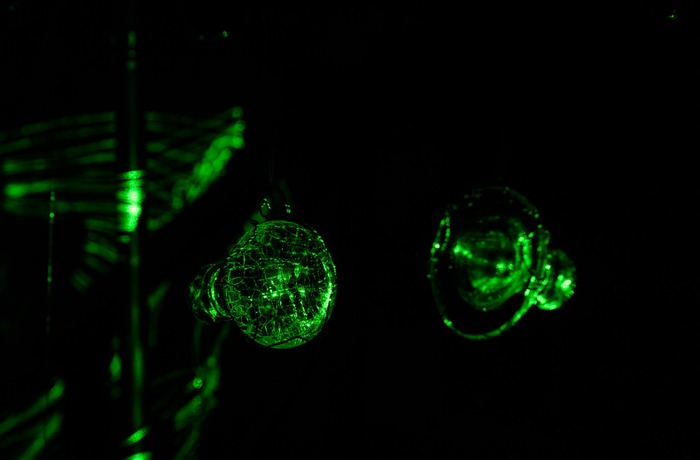Hamistagan
New Media Installation/Immersive Experience
Glass, laser, parametric speakers, instagram data scraping
@ Flash Biennale
1-10.11.2019
Glass, laser, parametric speakers, instagram data scraping
@ Flash Biennale
1-10.11.2019


”As described in the 9th-century Zoroastrian text Dadestan-i Denig ("Religious Decisions") hamistagan or hamēstagān is a neutral place or state for the departed souls of those whose good deeds and bad deeds were equal in life“
Hamistagan elaborates sousveillance, attention economy, opacity, and economical shift based on intellectual property. While this interactive installation is situated in area connotated to the history of the wartimes, it contemplates the current forms of oppression on the information age. Hamistagan adds real-time #flash2 data scraping from Instagram to illustrate the dialogues between now and then. While Dadaism and Abstract Expressionism served as artistic forms of overcoming the postwar condition, now with realms of selfies and hashtags of social media - especially after the era of terrorist acts - prosumers express: "I'm here, I'm ok".
Till recently, the surveillance has been executed by the church, the police, the government, the God, the surveillance camera, the paparazzi…
In our contemporary society, surveillance is executed by us and I, as an individual myself, who is contributing to this process. We produce the documentation, the monitoring of behaviour and activities while using, most commonly, our mobile devices. The mobile apps that are designed to make procedures and user-flow convenient and easy for us contain accurate and explicit/exact metadata (Exif =exchangeable image file format) that expose time and date, place and location,- the camera configurations and position and the unique ID number of the device. (Not to mention that our face and own identity detached to mentioned above.)
Meanwhile, Google is mapping out our planet with the images of every single street, AI and machine learning in collaboration with our half-manually executed labour now enable to produce the images of the places and spaces where Google do not reach, like the indoors or hidden locations such as inside of Suomenlinna fortress and its stonewall caves.
Sousveillance is a form of surveillance, substituting the prefix sous, "from below" (French). It consists of the recordings by the participant of an activity. The wearable computing devices has allowed for the collection of data in a different situation
As mentioned, this work consists of real-time #flashbiennale data scraping from Instagram to illustrate the dialogues between now and then. The colour, speed and pattern of light slowly evolve based on the frequency of hashtags posted on Instagram.
The generative soundscape consists of elements such as 35mm camera, satellite and the bell of the Suomenlinna church depicting the history of the relationship of power and surveillance.
Given the circumstances, the biennale visitor has participated to Hamistagan by posting on Instagram and the hashtags will be read out aloud by our synthetic friends represented in audio format: Daniel, Whisper, Satu and Karen.
The glass as a choice of material experiments as the beginning of a research and explorations process falling under the theory of media archaeology. The chosen design of the glasswork tributes for the history of technology and post-millennium aesthetics of the objects manufactured from rare materials and resources that inflict unequal sociopolitical conditions and destroy our natural resources while politicians are closing their eyes in favour of boosting the national (global) economy.
Special thanks to:
Jyri Lahelma and Flash2 festival crew.
For the recent discussions at the Department of Media Doctoral School led by Professor of New Media Lily Diaz and guest speaker: artist Hasan Elahi. Dr Samir Bhowmik, lecturer in Media Archeology and Media and Environment.
Thank you to Open Knowledge of Finland and The Reporters without Borders for the in-depth learning curve within the under the vast thematic of surveillance and transparency.
Hamistagan in the media:
Suomenlinna
Aalto University
